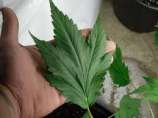acespicoli
Well-known member
Hemp Husbandry
Robert A. Nelson
Copyright 1999 ~ All rights reserved.
Table of Contents
Frontispiece (1 MB): "G. Washington & T. Jefferson Inspecting a Field of Hemp, ca. 1774. (Harry S. Robins, 1994)
1. The First Crop
2. Hemp Husbandry1. Introduction ~ 2. Hemp & Health ~ 3. Hemp in America ~ 4. Hemp Cloth ~
5. Hemp Paper ~ 6. Hemp Products ~ 7. Biodiesel ~ 8. Hemp: A Renewable Resource ~
9. Other Fiber Plants ~ 10. Hempseed & Nutrition ~ 11. Hempseed Oil ~ 12. References
3. Hemp Fiber1. Introduction ~ 2. Soil ~ 3. Water ~ 4. Temperature ~ 5. Sowing ~ 6. Cultivation ~
7. Diseases & Pests ~ 8. Nutrients ~ 9. Cultivating for Cannabinoids ~
10. Growth Stimulants ~ 11. Harvest ~ 12. Hempseed ~ 13. Apologia ~ 14. References
4. Botany & Breeding1. Retting ~ 2. Hurds ~ 3. Decortication ~ 4. Hemp Fiber Technology ~ 5. Hemp Paper ~
6. References
5. Electro-Culture1. Classification ~ 2. Description ~ 3. Trichromes ~ 4. Phenotypes ~ 5. Genetics ~
6. Polyploidy ~ 7. Breeding ~ 8. Light ~ 9. Sexual Expression ~ 10. References
6. Cannabinoid Chemistry1. Introduction ~ 2. Antennas ~ 3. Electrostatics ~ 4. DC ~ 5. AC ~ 6. Magnetism ~
7. Electrogenics ~ 8. Sound ~ 9. Light ~ 10. References
Appendix 1: Resources1. Cannabinoids ~ 2. Extraction ~ 3. Acetylation ~ 4. Isomerization ~ 5. Identification ~
6. Neurology ~ 7. References
Appendix 2: James Allen: The Reign of Law
Appendix 3: Polemics Against Prohibition
Index
Tables:
Figures: (Not included in the Online Edition)1.1 Comparison of Wood & Hurds
1.2 Analysis of Hempseed
1.3 Mineral Assay of Hempseed
1.4 Protein Analysis of Hempseed
1.5 Properties of Hempseed Oil
1.6 Fatty Acid Analysis
2.1 Economic Feasibility of Hemp
2.2 Production Costs of Hemp
2.3 Nutrient Deficiency/Excess
2.4 Plant & Soil Interrelationships
2.5 Hemp Farming
3.1 TraditionalHemp Processing
3.2 Breakdown of Hemp
3.3 Colorimetric Identification
3.4 Comparison of Wood & Hurds
4.1 Cannabis Genotypes
This "Hemp Husbandry" article is reprinted with permission from Robert A. Nelson. The article is included on Hemp Basics as it appears on his own site, Rex Research










